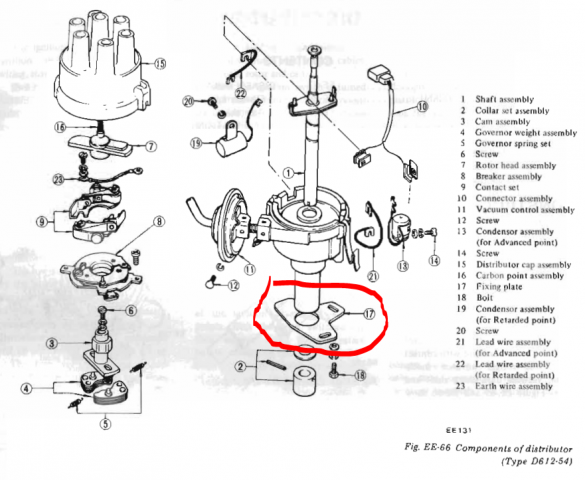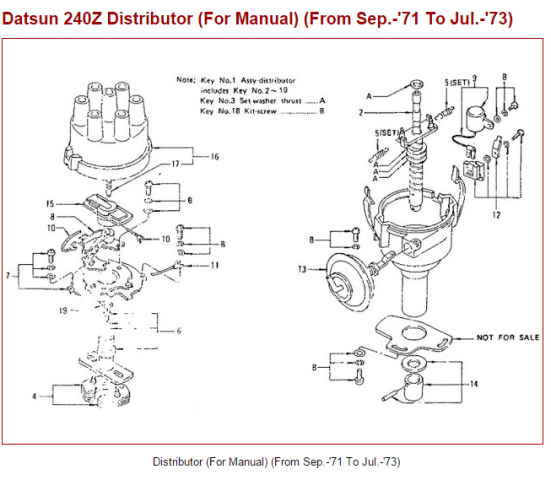
NewZed
Members-
Posts
6700 -
Joined
-
Last visited
-
Days Won
72
Content Type
Profiles
Forums
Blogs
Events
Gallery
Downloads
Store
Everything posted by NewZed
-
The last one looks like a typical long nose R200 axle. They clip in. The circlip is inside the diff. Not sure about the spline counts but people get hub axle and diff axle spline counts confused often. Here's a link with some R180 stuff - http://forums.hybridz.org/topic/49194-differential-cv-lsd-hp-torque-r160-r180-r200-r230-diff-mount/ Lots of good stuff in the P&D chapters also - http://www.nicoclub.com/FSM/280z/
-
how to install a fuel pressure regulator and rail
NewZed replied to 280zmonstar's topic in Nissan L6 Forum
Look at the 4th item down in the link below. "how to" start a new thread. http://forums.hybridz.org/forum/68-new-members-forum/ youtube is probably a better bet for finding instructions on something so generic. -
Fuses only blow if something is not right. It's not a "normal" to use a car with blown fuses. Find the short.
-
On a 76 280Z non-working gauge lights is a sign that the tail light fuse is blown.
-
Forged Pistons for L28 F54 block with P90 head.
NewZed replied to RaGnaR_RattmuFF's topic in Nissan L6 Forum
It would depend on the head (combustion chamber size). The dished pistons will give ~7.4 with a P79 or P90 head, or 8.3 with a N42 or N47 head. The flat-tops will give 8.8 or ~10, respectively (calculator results vary on the last one, others are from the FSM's). Assuming no major machining done to the sealing surface. There's only two options and the flat-top's are labeled as flat-tops. The picture shows dished in the other link. They're just stock design replacements. Flat-tops http://www.thezstore.com/page/TZS/PROD/classic12d08/10-4080 Dished http://www.thezstore.com/page/TZS/PROD/classic12d08/10-4081 -
People have trouble bleeding brakes all the time. You might be over-analyzing (no jokes, please). Can you pump the pressure up? That could be air. How much play is there between the pedal and the MC piston moving (have someone watch the fluid in to and out of the reservoir). The volume of fluid moving in/out of the reservoir is a good sign of air in the system also. The volume is compressing the bubbles. Finally, most people do this MC conversion as part of other brake work. So, what other brake work did you do? Toyota calipers, maybe? Rear discs? They have their own issues.
-
The gland nut "seats" on the top of the shock body, inside the strut tube. It does not seat on the outer tube. The shock body fits up inside the gland nut. 1/8" is a normal gap, and a good sign.
-
Here are some links to look at, showing the different bolt patterns and how the parts ift together, with labels. Seems like you should be able to swap companion flanges on a ZX to run CV's instead of u-joint shafts. I've never seen it described but it seems simple. People install 280ZX companion flanges (turbo or 2+2) in to 240Z hubs to run 280ZX CV shafts. Same concept. http://www.nicoclub.com/FSM/280z/1982/1982%20280zx%20FSM/ra.pdf http://forums.hybridz.org/topic/49194-differential-cv-lsd-hp-torque-r160-r180-r200-r230-diff-mount/
-
Can't bleed my clutch 1976 280z coupe
NewZed replied to lorenzo's topic in S30 Series - 240z, 260z, 280z
How far? Details. You might try raising the front or back of the car to make sure the bleed screw is at the highest point. The bubble can sit at the high spot while fluid goes out the bleeder. It's a simple system, but small details can get you. Like I said did you check the slave cylinder boot and you said that you "checked for leaks". Might not be thorough enough. You have to remove the boot to know if the cylinder is leaking, the fluid will stay inside. So a glance at it by eye won't do it. Might take some thought and study to understand. If you replaced the clutch parts because your shift lever was wiggly, there's much to learn. -
Can't bleed my clutch 1976 280z coupe
NewZed replied to lorenzo's topic in S30 Series - 240z, 260z, 280z
Are these new parts? Rebuilt? Was anything else done? Have you checked the slave cylinder boot to see if there's a leak? Did the old parts work? Why'd you replace them? Lots of detail missing. Have someone watch the slave cylinder rod and clutch fork while you push the pedal, or vice-versa. -
Rough start troubleshoot - '78 280Z
NewZed replied to Alda's topic in Trouble Shooting / General Engine
Sounds like a weak fuel pump. A fuel pressure measurement would tell. Leave the gauge attached and look at it when the problem happens. -
The shaft axles will swap in to the R200, but the flange on the other end might not bolt up. Depends on your hub axle companion flange bolt pattern.
-
Are you posting for yourself? How many dead threads are you going to try to resuscitate? And where are you getting all of this advice? 3 weeks ago you were asking how much power an L28 might make. Regurgitating and recycling internet knowledge as your own is not cool. The two posts above look like pure fabrication. You should stop doing that. http://forums.hybridz.org/topic/122898-all-streetability-aside-28l/
-
STIFF lowering springs, not coilovers
NewZed replied to seventyfour's topic in Brakes, Wheels, Suspension and Chassis
I'm not a suspension expert but I think that a well-designed wheel/car/suspension system never rubs. The wheel stops moving before rubbing occurs. So one solution for you might just be more or longer bump stops. This will stop the rubbing, and you can keep the look, but the ride will still suck because you don't have enough travel. That's one of your problems, besides spring and shock rates. Your parts don't work together. -
Are they shown in the schematic but you don't know what they do? Or are they on the switch but not shown n the schematic? Are they #6 and #7, or one of the five. If you have a meter you could at least chem them for either ground or power.
-
STIFF lowering springs, not coilovers
NewZed replied to seventyfour's topic in Brakes, Wheels, Suspension and Chassis
Where do they rub? Which springs have you looked at so far? Make a list, so you can avoid the "already saw those" cycle. "Coilovers" only offer adjustable ride height, if they're the design that just moves the spring perch up or down. Otherwise, they use the spring the same as a fixed perch. -
http://www.herningg.com/projects/groovyheads.html Edit - sorry for loading up your thread. I see that you decided to avoid the wild stuff. Good luck.
-
Speed Secrets (capitalized). PipeMax version 4.0. Magical dimples. All of the below is true? Dryer exhaust ports? Because the fuel is burned so efficiently? Can't believe it. " 15-25-plus horsepower increases, a wider power curve, sometimes 100 to 300 higher RPM point of peak horsepower, less fuel consumed on the Dyno ( lower BSFCs ) and dryer exhaust ports. On the flow bench, basically no flow gains I can measure from roughing up the entire heads/manifold surfaces." There's a psychological factor involved when people do these "experiments" and odds are that other things were changed that affected horsepower in those hot rod magazine tests. "Oh yeah, I advanced timing 10 degrees, but it shouldn't matter" kind of stuff. Subconscious. That's giving the guy the benefit of the doubt. It might just be pure BS, to sell Speed Secrets. Just saw that Naptown Dave already commented re the golf ball. I didn't see the actual "theory" either, that better atomization caused all of the described benefits. The best explanation for something that can't be explained is in terms of something that can't be measured.
-
I thought golf ball dimples were for consistent air flow over the surface of the ball, so that they fly true. Not for more distance, from lower drag. If dimples helped flow, airplane wings and fuselages would definitely be dimpled. Sounds like voodoo.
-
Open up the mini-junction, look at the distributor wire ends, and all will be clear.
-
I pulled all of the "red flag" statements from your post. That engine combination is an odd one, not what an experienced "Z" person would put together unless they had planned for a turbo. (EDIT - actually, with the flat tops, that's a typical ZX engine. 8.8 CR. My mistake.) Makes you wonder. The "new" head (not rebuilt) makes me think it came from California Datsun (formerly Datsun Parts LLC), one of the only suppliers around, but one who hasn't mastered the art of the Z. I wouldn't drive one of his engines or heads across the country without making sure everything was in spec. "New" just means clean and worked on. SUs can be finicky and many people spend a lot of time getting them dialed in. Considering the odd assembly of parts you have it would be surprising if they were ready to go. The air temperature sensor is in the AFM already (on most AFM's). But most people don't run an AFM with Megasquirt. The cold start valve is described in the FSM. This kind of shows where you're EFI knowledge is at this point. Most people have a hard time learning EFI, so learning EFI from scratch, and Megasquirt, and getting it all sourced, and installed, and tuned, in one month is really a ludicrous proposition. Michael Wales says that his EFI swap can be done in a couple of days but it took him a month and a half just to source all of the parts. His buddies probably knew something about 240Z's or cars in general also. Forget about 12 hours. Finally, it's a 1971 240Z. The rest of the car is probably worn out too. Best to focus on bearings, and bushings, and transmission, and all of the other parts that get hot and fail on long road trips. If you do get lucky and make a choice and source all of the parts you need in just a few days then you could revisit the idea. But you'll probably get stuck on just finding a 280Z intake manifold. Don't disassemble anything on the engine until you have all of the other parts you need. Odds are though that you're going to find a problem on your new car that throws a wrench in to all of your plans. The EFI swap will be irrelevant. Welcome.
-
How fast with stock stubs and flanges?
NewZed replied to Eric JB's topic in Gen I & II Chevy V8 Tech Board
Miles has a 240Z which has weaker hub axles than a 280Z. Here's some threads re your question. Search the names to get more information. Rebekahsz is another who was drag racing, but on the stock axles. http://forums.hybridz.org/topic/109324-ford-88-irs-conversion/ http://forums.hybridz.org/topic/121328-snapping-stub-axles-now-what/?hl=sunnyz&do=findComment&comment=1135160 And here's a guy supplying the market - http://forums.hybridz.org/topic/121613-s30-ultimate-88-irs-swap-kit/ -
It still has the wrecking yard mark on it. Added two pictures just to confuse things, hard to tell what's right but it does show options. One from a parts web site and one from the FSM. Might as well flip it over and see.


